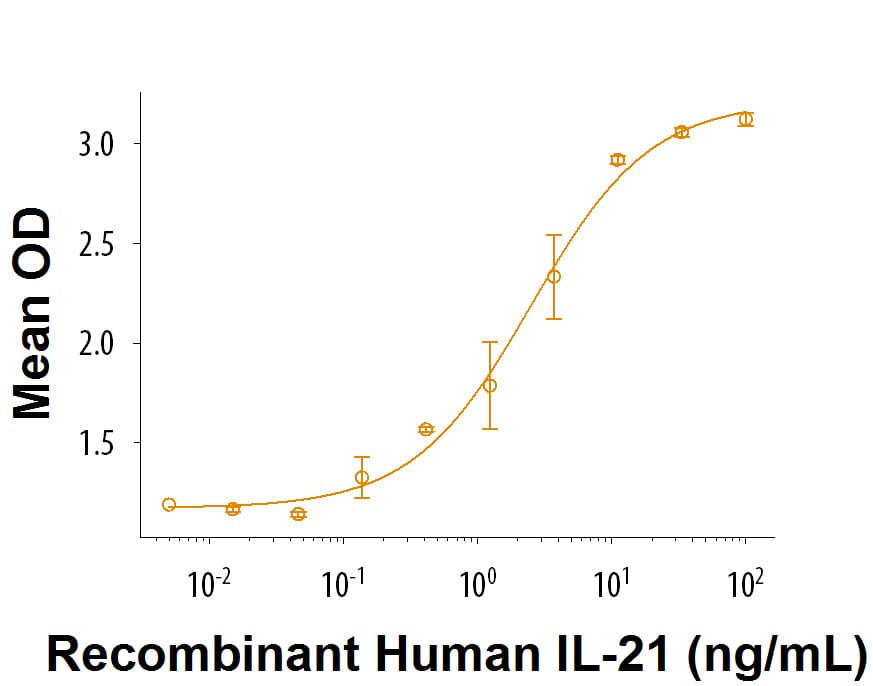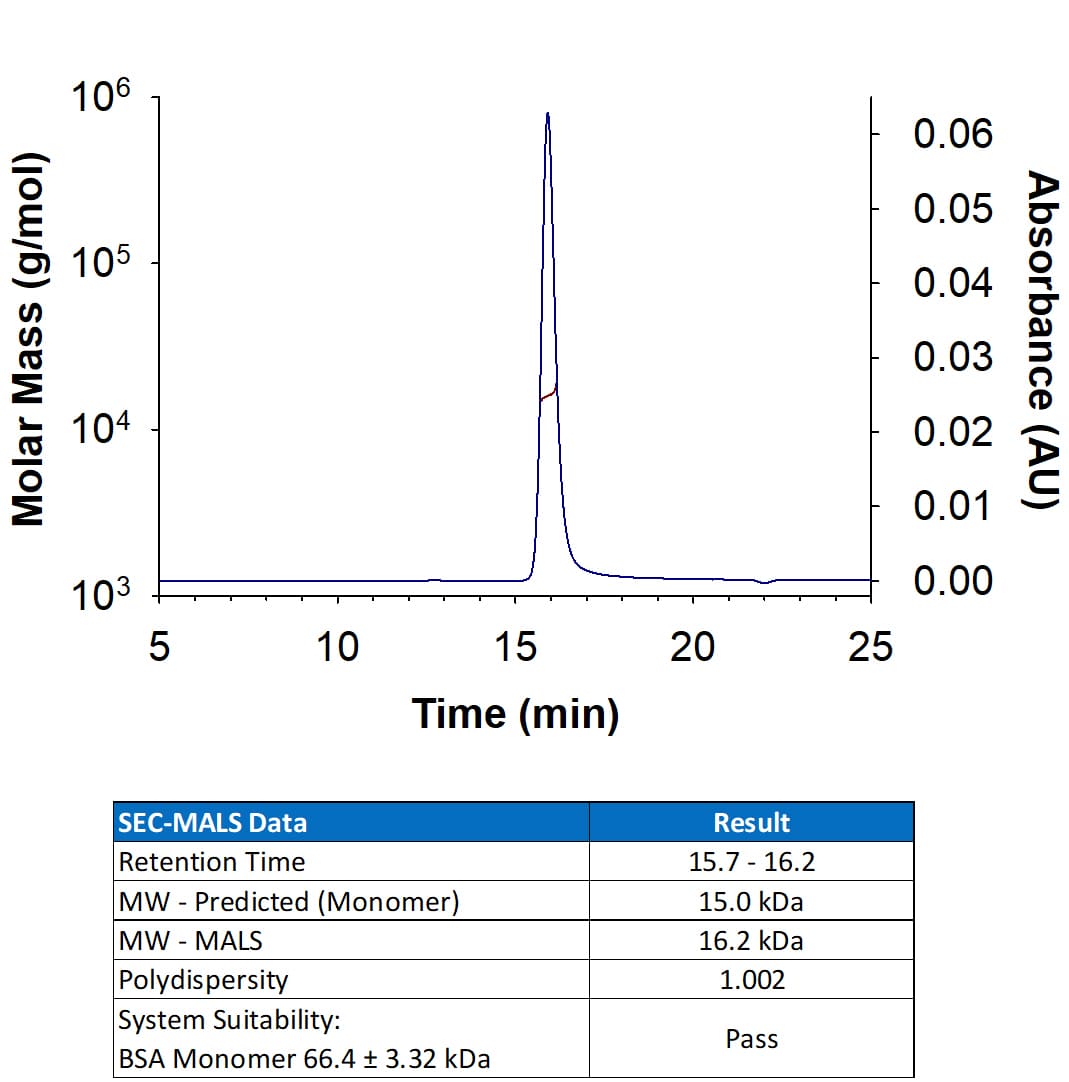



 下载产品说明书
下载产品说明书 下载SDS
下载SDS 用小程序,查商品更便捷
用小程序,查商品更便捷



 收藏
收藏
 对比
对比 咨询
咨询Scientific Data
 View Larger
View LargerRecombinant Human IL-21 Protein (Catalog # 8879-IL) has a molecular weight (MW) of 16.2 kDa as analyzed by SEC-MALS, suggesting that this protein is a monomer.
 View Larger
View LargerRecombinant Human IL-21 (Catalog # 8879-IL) enhances IFN-gamma secretion in NK-92 human natural killer lymphoma cells. The ED50 for this effect is ≤ 8 ng/mL.
Carrier Free
CF stands for Carrier Free (CF). We typically add Bovine Serum Albumin (BSA) as a carrier protein to our recombinant proteins. Adding a carrier protein enhances protein stability, increases shelf-life, and allows the recombinant protein to be stored at a more dilute concentration. The carrier free version does not contain BSA.
In general, we advise purchasing the recombinant protein with BSA for use in cell or tissue culture, or as an ELISA standard. In contrast, the carrier free protein is recommended for applications, in which the presence of BSA could interfere.
8879-IL
| Formulation | Lyophilized from a 0.2 μm filtered solution in PBS with BSA as a carrier protein. |
| Reconstitution | Reconstitute at 100 μg/mL in PBS containing at least 0.1% human or bovine serum albumin. |
| Shipping | The product is shipped at ambient temperature. Upon receipt, store it immediately at the temperature recommended below. |
| Stability & Storage: | Use a manual defrost freezer and avoid repeated freeze-thaw cycles.
|
8879-IL/CF
| Formulation | Lyophilized from a 0.2 μm filtered solution in PBS with Trehalose. |
| Reconstitution | Reconstitute at 100 μg/mL in PBS. |
| Shipping | The product is shipped at ambient temperature. Upon receipt, store it immediately at the temperature recommended below. |
| Stability & Storage: | Use a manual defrost freezer and avoid repeated freeze-thaw cycles.
|
Recombinant Human IL-21 Protein Summary
Product Specifications
Gln32-Ser162 with a N-terminal Met
Analysis
Background: IL-21
IL-21 (Interleukin-21) is a potent cytokine regulating many cell types of the immune system. IL-21 is produced by activated T follicular helper cells (Tfh), Th17 cells, and NKT cells (2-6). Tfh-derived IL-21 plays an important role in the development of humoral immunity through its autocrine effects on the Tfh cell and paracrine effects on immunoglobulin affinity maturation, plasma cell differentiation, and B cell memory responses (4, 8, 9). IL-21 protein regulates several aspects of T cell function. It co-stimulates the activation, proliferation, and survival of CD8+ T cells and NKT cells and promotes Th17 cell polarization (3, 5, 6, 11, 12). IL-21 blocks the generation of regulatory T cells and their suppressive effects on CD4+ T cells (13, 14). In addition to its role in T cell biology, IL-21 also plays a critical role in B cell activation, proliferation, differentiation, and apoptosis (2). It is also required for the migration of dendritic cells to draining lymph nodes (10). And IL-21 suppresses cutaneous hypersensitivity reactions by limiting allergen-specific IgE production and mast cell degranulation (16). In the autoimmune disease Systemic lupus erythematosus (SLE), a link between IL-21 and SLE disease susceptibility and progression was recently reported (19).
IL-21 protein exerts its biological effects through a heterodimeric receptor complex of gamma c and the IL-21-specific IL-21 R (2, 7). IL-21 is an approximately 14 kDa four-helix-bundle member of the family of cytokines that utilize the common gamma chain (gamma c) as a receptor subunit. gamma c is also a subunit of the receptors for IL-2, IL-4, IL-7, IL-9, and IL-15 (1). IL-21 R engagement enhances the cytolytic activity and IFN-gamma production of activated NK cells but limits the expansion of resting NK cells (15). Dysregulation of the IL-21/IL-21 R system contributes to the development of multiple immunological disorders (1, 17). The 133 amino acid (aa) mature human IL-21 protein shares 63% and 61% aa sequence identity with mouse and rat IL-21 protein, respectively. Alternative splicing generates an additional isoform with a substitution of the C-terminal 16 amino acids (18).
- Tangye, S.G. (2015) Curr. Opin. Immunol. 34:107.
- Parrish-Novak, et al. (2000) Nature 408:57.
- Coquet, J.M. et al. (2007) J. Immunol. 178:2827.
- Vogelzang, A. et al. (2008) Immunity 29:127.
- Korn, T. et al. (2007) Nature 448:484.
- Nurieva, R. et al. (2007) Nature 448:480.
- Asao, H. et al. (2001) J. Immunol. 167:1.
- Zotos, D. et al. (2010) J. Exp. Med. 207:365.
- Rankin, A.L. et al. (2011) J. Immunol. 186:667.
- Jin, H. et al. (2009) J. Clin. Invest. 119:47.
- Frohlich, A. et al. (2009) Science 324:1576.
- Yi, J.S. et al. (2009) Science 324:1572.
- Peluso, I. et al. (2007) J. Immunol. 178:732.
- Bucher, C. et al. (2009) Blood 114:5375.
- Kasaian, M.T. et al. (2002) Immunity 16:559.
- Tamagawa-Mineoka, R. et al. (2011) J. Invest. Dermatol. 131:1513.
- Ma, J. et al. (2011) Cytokine 56:133.
- Rahman, M. et al. (2007) FEBS Lett. 581:4001.
- Wang, et al. (2018) Nature Commun. 9: 1758.


参考图片
Recombinant Human IL-21 (Catalog # 8879-IL) stimulatesN1186 human T cell proliferation. The ED50 for this effect istypically 2-12 ng/mL.






 危险品化学品经营许可证(不带存储) 许可证编号:沪(杨)应急管危经许[2022]202944(QY)
危险品化学品经营许可证(不带存储) 许可证编号:沪(杨)应急管危经许[2022]202944(QY)  营业执照(三证合一)
营业执照(三证合一)